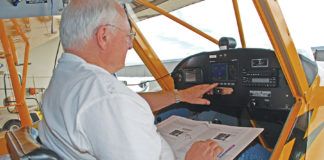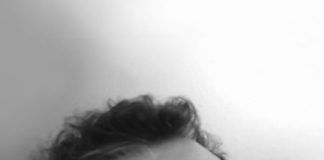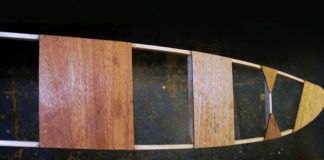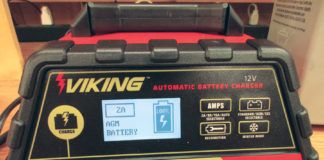Cmon. You’ve done it. I know you have. Your buddy gets his plane back from the paint shop, and you begin eyeballing it for mistakes. The need to know if the painter has done a good job is palpable. Your own plane is nearing completion and you’ve decided not to paint it yourself, so the time has come to begin checking out paint shops. How do you proceed? Here, then, some builders and paint shop owners offer their advice on how to manage the paint shop experience successfully.
Builders Perspective
Art Bertolina, a Lancair IV-P owner, checked with other Lancair builders to find out what paint shops they had used. He inspected the planes to see if there were noticeable mistakes or sloppy runs, and he visited the paint shops to inspect the aircraft being painted there. Then he and his wife, Suszie, combined their ideas for a Southwest design and took it to John Stahr of Stahr Designs for implementation. Stahr had come to the couples attention via lofty recommendations, and the planes Bertolina had seen earned high marks in his book. With Stahrs artistic talent, the Bertolinas achieved exactly what they wanted and more. Stahr suggested they include the image of a thunderbird on the underside of their aircraft, and they agreed. They could not be happier, and Stahrs unexpected idea gave the plane the pizzazz they sought.
Bertolina researched several paint shops before settling on Stahr. He wanted to be sure that communication between the two of them would be concise and understood. There was an initial concern about the distance between the two, what with Bertolina in Southern California and Stahr in Oregon, but that immediately became a non-issue. Stahr says hes a firm believer in good communication.
When you are discussing your goals for the project with the paint shop, both in terms of the design and the quality of the work, it is imperative that you are able to convey your ideas, whether in person, on the phone or via email. As with any relationship, good communication helps to ensure a desirable outcome. If you don’t think the paint shop owner is listening to what you are saying, or if your personalities don’t mesh, find another shop! You don’t want to leave your project in the hands of a person you don’t trust and with whom you feel timid, says Stahr. You must be clear about the outcome you wish to achieve.
Wes King built his Harmon Rocket in Canada and worked with Brian Kernohan of Centralia, Canada, on his design. Kernohan listened to Kings ideas and brought them to life. A stylized checkerboard was painted on the rudder (there are silver lines between the checkers, allowing the colors to stand alone rather than bleed into each other). King chose Inferno Red and a shade of blue from the Jeep Grand Cherokee line as his color palette. With those two trim colors and a light silver base coat, all metallics, he was ready to go.
Kernohan emailed photos to King each step of the way, and King felt the communication was fantastic. He had absolutely no fix-its to deal with. He recommends that prior to choosing a paint shop, look carefully at several aircraft painted by the shop and be comfortable with what you see. He wanted a tasteful, catchy, but not ostentatious paint scheme, and the job met the mark. He also did not want the paint process to take an extended period of time, and he was able to get a turnaround time of 10 weeks. Be sure to get yourself on a paint shops schedule once you have a reasonably firm completion date and, to be cautious, always build into your calendar more time for the job than the shop estimates.
Skip Slater said that when he searched for a paint shop for his Lancair ES, certain considerations were important to him. The shop had to be close enough that he could check in on the work, and the shop had to allow him to do the disassembly and reassembly of the aircraft, which would save him money. He suggests that when choosing a shop, recognize that touch-ups are a part of life, so it is more convenient to have the shop close to your home base. Slater also set realistic goals. He was not looking for a perfect, award-winning paint job, but rather one that pleased his particular palate.
Customer Relations
Stahr claims he has never had an unhappy customer, as he typically does the design and painting himself. Working with graphics programs on his Mac computer, first in the design studio and then often in the paint shop, Stahr creates dynamic visuals that can be printed for clients. If they have difficulty envisioning the design, he can paint a panel with the actual paint or special effects chosen. He says hell edit the design until the details have been worked out and the customer is satisfied. In some cases he has used the actual colors on a model of the aircraft. This equates to extra time and effort, of course, and therefore additional expense, but it may be worth it to some. Stahr believes that if a customer experiences post-paint-depression, the communication process probably wasn’t good enough. Most shops will work with a client to assure they are satisfied, as their reputation is on the line. A blog of unhappiness can spread like wildfire on the Internet, and can be the bane of a paint shops existence.
As with any individual project, down-time is critical to the pilot. The complexity of the paint design, the type of foundation (i.e., aluminum, composite, etc.), and the amount of prep time on the skin will dictate the estimate of how long the paint shop will have your plane. This will also determine the cost of the work to be completed.
Kernohan suggests that builders not prime the plane before bringing it in for the final coats of paint. With fiberglass, he says, the product is porous and much work needs to be done to make it smooth. Builders will often fill and prime, but he says he could do the work in half the time, and it would be cheaper in the long run. Because of the variety of primers on the market, he has no idea what kind of chemical reaction will occur between his paint and the builders primer. Most often the primer needs to be removed, and he starts from scratch in order to guarantee the work.
Kent Pielemeier of Century Aircraft Painting in Chino, California, says he works well with his clientele, and a number of builders surveyed for this article agreed. As with Kernohan, both Pielemeier and Stahr encourage clients to come by the shop, even daily, for a progress check. All of these shops will email out-of-town clients with reports and photos, showing the steps done along the way. Phone calls are also made at several points in the process to assure all is well, and the customer and the shop are still on the same page. Because the reputations of the paint shops are at stake, there is no benefit to hiding any of the activity done on the project. If a shop discourages your participation in the paint process, turn and run in the opposite direction, all of these folks say. Stahr understands homebuilders, and recognizes that homebuilt aircraft projects, with the builders investment of time, money and effort, sometimes become almost like a member of the family, and owners may have strong feelings of affection and protectiveness. You wouldn’t leave your child with someone you don’t trust, so don’t do so with this life project.
Managing Expectations
Stahr informs clients that the search for perfection is a long, slippery slope that is very expensive. When deciding how much you want to spend on your paint job, he suggests looking at what you are really trying to achieve. Is it an aircraft that is used for everyday flying, such as heading to lunch with friends and traveling, or is the intent to win an award at Oshkosh? The answer to these questions will dictate the time-and the budget-required to do the job.
In terms of when you should expect to get on the paint shops calendar, all shops will differ based on their commitments. But all three shops mentioned that they can usually get customers on their schedule within a few months. Plan accordingly. Good organization and scheduling allow a shop to keep its work moving and on target to avoid a backlog of anxious clients.
Sadly, the shop Slater used closed down a few years after he had his plane painted, and later touch-ups were not an exact match. Still, he was pleased with his choice. He says they stayed within the budget he projected and were only a little over the time frame anticipated. He cautioned that a painter who charges twice as much will likely not do twice as good a job. He also admits that he was not looking for a show plane, but considers his paint job stunning nonetheless, at nearly half the cost of the highest estimate he had received.
King recalls that in 2005 the paint job on his Rocket cost less than $10,000, which he considered a fair price. The end result looks like it could have cost far more.
Post-Paint
When the paint job is completed and the airplane is ready to be released, most pilots fly the plane home. A few years back, a pilot (who shall remain nameless) went to pick up his plane and did not notice the tape covering the pitot system. After he noted that he had no airspeed indicator, he aborted the takeoff and located the problem. Be extra vigilant when pre-flighting after the shop has disassembled and reassembled your plane. It would be helpful to have the shop make a list of all items taped over to assure that they have removed the tape upon completion of the job. This raises another point: Make sure that the things that should have been disassembled prior to painting actually were disassembled. Painting over screws will promote chipping when parts are removed.
The reality is that you, the builder, want your aircraft to shine amongst all others after investing years of sweat equity. Several of the aircraft pictured here offer points to ponder when evaluating the quality of a paint job. Take the time to research paint shops, and be sure you have a realistic idea of how long your aircraft will be out of service for the paint process. Get a written estimate of the total cost, and ask for an itemized list of the work to be done. Check it against the final result. Do your part to ensure that communication is the best it can be and that everyone concerned understands not only what you are trying to achieve, but also what you will get for the money you’re spending. Inspect the work thoroughly before flying. Lastly, give your airplane the best coat of paint you can afford. It deserves it!













